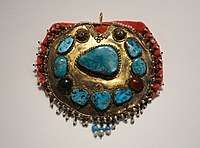South Arabia
South Arabia is a historical region that consists of the southern region of the Arabian Peninsula, mainly centered in what is now the Republic of Yemen, yet it has also historically included Najran, Jizan, and 'Asir, which are presently in Saudi Arabia, and the Dhofar of present-day Oman.
Part of a series on the |
|---|
| History of Yemen |
 |
| Timeline |
It is roughly the same as Greater Yemen.
South Arabia is inhabited by people possessing distinctive linguistic and ethnic affinities, as well as traditions and culture, transcending recent political boundaries. There are two indigenous language groups: the now extinct Old South Arabian languages and the unrelated Modern South Arabian languages, both members of the Semitic family.
Etymology
The term Yamnat was mentioned in Old South Arabian inscriptions on the title of one of the kings of the second Himyarite kingdom known as Shammar Yahrʽish II. The term was probably referring to the southwestern coastline of the Arabian peninsula and the southern coastline between Aden and Hadramout.[1][2][3][4] One etymology derives Yemen from ymnt, meaning "South", and significantly plays on the notion of the land to the right (𐩺𐩣𐩬).[5] Other sources claim that Yemen is related to yamn or yumn, meaning "felicity" or "blessed", as much of the country is fertile.[6][7] The Romans called it Arabia Felix (fertile Arabia), as opposed to Arabia Deserta (deserted Arabia). Classical Latin and Greek writers used the name "India" to refer to South Arabia (ancient Yemen). The use of the term "India" arose from the fact that the Persians called the Abyssinians whom they came into contact in South Arabia by the name of the dark-skinned people who lived next to them, i.e., Indians.[8]
History

Three thousand years ago, several ancient states occupied the region of South Arabia, being M'ain, Qataban, Hadhramaut, and Saba.[9] In these ancient times South Arabia claimed several notable features: the famous dam at Marib, the cosmopolitan incense trade, as well as the legendary Queen of Sheba.[10] Two thousand years ago the Himyarites became the masters of South Arabia, dominating the region for several centuries. The Ethiopian Kingdom of Aksum invaded South Arabia first in the 3rd–4th centuries, then later in the 6th under King Kaleb who subjugated the region, c. 520. They were displaced by Persian forces of the Sassanid dynasty, c.575, who also arrived by sea.[11][12][13][14] A half-century later, in the year 6 A.H. (628), the region converted to Islam.[15]
Ancient South Arabia
Ancient kingdoms and appellations:
- Saba'
- Ma'īn
- Qatabān
- Ḥaḑramawt
- Awsān
- Himyar
- Arabia Felix (the term the Romans used to refer to South Arabia)
Pre-Islamic foreign occupiers:
- Axum (3rd–4th, 6th centuries)
- Sasanian Empire (6th–7th centuries).
South Arabian Islamic dynasties
South Arabia in the early modern and colonial eras

- Northern
- Yemen Eyalet, Ottoman Empire (1517–1635)
- Yemen Vilayet, Ottoman Empire (1849–, 1872–1918)
- Idrisid Emirate (1906–1934)
- Southern
- Aden city
- Aden Province (1839–1937)
- Colony of Aden (1937–1963)
- Regional
- Aden Protectorate (1874–1959)
- Federation of Arab Emirates of the South (1959–1962)
- Federation of South Arabia (1962–1967)
- Protectorate of South Arabia (1963–1967)
- Aden city
South Arabia in recent history
Independent Yemen:
- Unified
- Republic of Yemen (1990–present)
- Northern
- Idrisid Emirate (1906–1934)
- Mutawakkilite Kingdom of Yemen (1918–1962)
- Yemen Arab Republic (1962–1990)
- Southern
- Qu'aiti Sultanate (1858–1967)
- People's Republic of South Yemen (1967–1970)
- People's Democratic Republic of Yemen (1970–1990)
- Other articles
- Yemenite Reunification (1990)
- North Yemen & South Yemen
- Democratic Republic of Yemen (1994)
- Greater Yemen
- Houthi insurgency in Yemen (2015)
South Arabia outside the Republic of Yemen
- Najran, Jizan, 'Asir in Saudi Arabia
- Dhofar in Oman
See also
References
- Jawād ʻAlī (1968) [Digitized 17 February 2007]. الـمـفـصـّل في تـاريـخ العـرب قبـل الإسـلام [Detailed history of Arabs before Islam] (in Arabic). 1. Dār al-ʻIlm li-l-Malāyīn. p. 171.
- Neuwirth, Angelika; Sinai, Nicolai; Marx, Michael (2010). The Qur??n in Context: Historical and Literary Investigations Into the Qur??nic Milieu. BRILL. ISBN 9789004176881.
- Burrowes (2010), p. 145
- Smith, William Robertson. Kinship and Marriage in Early Arabia. p. 193. ISBN 1117531937.
He was worshiped by the Madhij and their allies at Jorash (Asir) in Northern Yemen
- Beeston, A.F.L.; Ghul, M.A.; Müller, W.W.; Ryckmans, J. (1982). Sabaic Dictionary. University of Sanaa, YAR. p. 168. ISBN 2-8017-0194-7.
- Vladimir Sergeyevich Solovyov (2007). Enemies from the East?: V. S. Soloviev on Paganism, Asian Civilizations, and Islam. Northwestern University Press. p. 149.
- Edward Balfour (1873). Cyclopædia of India and of Eastern and Southern Asia, Commercial, Industrial and Scientific: Products of the Mineral, Vegetable and Animal Kingdoms, Useful Arts and Manufactures, Band 5. Printed at the Scottish & Adelphi presses. p. 240.
- Origin Of Islam In Its Christian Environment Bell, Richard p.g 34
- Brian Doe, South Arabia (London: Thames & Hudson 1971) at 60–102.
- Jean-Francois Breton, Arabia Felix (University of Notre Dame 1999) at 13–20, 23; 53–73; 3–5, 41–43.
- al-Tabari, The History of al-Tabari, volume V, The Sasanids, the Byzantines, the Lakmids, and Yemen (S.U.N.Y. 1999), in Yemen: Ethiopian conquest at 179, 182–183, 204–208, 212; Persia over al-Habashah at 159–160, 236–249.
- Stuart Munro-Hay, Aksum. An African civilization of late antiquity (Edinburgh Univ. 1991) at 71–74, 76–77 (3rd century), at 78–80 (4th century), at 84–88 (6th century).
- Sally Ann Baynard, "Historical Setting" in The Yemens: Country Studies (Washington, D.C.: Foreign Area Studies, The American University, c.1985) 1–89, at 3–14: Ethiopians at 11–12 (4th century for 4 decades, 6th century for about 50 years); Persians at xiii, 12.
- Guy Annequin, Little-Known Civilizations of the Red Sea (Geneva: Ferni 1979) at 196–202.
- al-Tabari, The History of al-Tabari, volume VIII, The Victory of Islam (S.U.N.Y. 1997) at 114 (became Muslim).